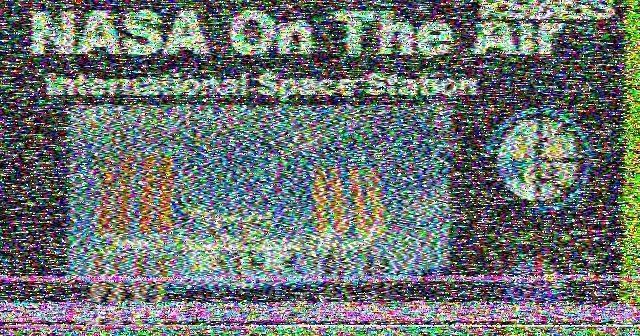ARRIS-SSTV Oct 27 write-up
Written on October 27th, 2018 by LZ2BKD
The International Space Station has events for broadcasting SSTV for various special occasions. After getting my license a month or so back, the first such SSTV event I learned about was the one on Oct. 27, highlighting 60 years of NASA on the air. I learned about the event a few days beforehand and didn’t get enough time to prepare as well as I wanted to, but got somewhat readable parts of two different images.
Preparation
The SSTV broadcast was scheduled to start at 10AM UTC on Saturday, which in LZ time was 1PM. In my location, the ISS had 3 passes for Saturday and 6 for Sunday.
Saturday
Start Highest End
10:22:16 10° NW 10:24:33 17° N 10:26:50 10° NE
11:58:56 10° N 12:01:51 28° NNE 12:04:46 10° E
13:35:18 10° WNW 13:38:33 56° SW 13:41:48 10° SE
Sunday
05:16:10 10° SSW 05:19:02 28° SE 05:21:54 10° ENE
06:52:21 10° W 06:55:28 40° NNW 06:58:37 10° NE
08:30:17 10° NW 08:32:37 18° N 08:34:59 10° NE
10:07:21 10° NW 10:10:00 22° NNE 10:12:39 10° ENE
11:43:36 10° NW 11:46:55 80° NE 11:50:14 10° ESE
13:21:25 10° WSW 13:23:01 13° SW 13:24:37 10° SSW
For Saturday, I had just one chance - 13:35 - 13:42, about 6-7 minutes. Earlier passes would have no scheduled broadcasts. The ISS would have transmitted for 20-30 minutes before, so I was hoping that I wouldn’t hit a scheduled radio silence between downlinks. I had read somewhere that the ISS broadcasts SSTV for two minutes and pauses for another two, as to not overheat the transmitter.
Sunday was looking better, but I had some errands scheduled in the morning and wasn’t planning to wake up early, so the earliest downlink I could catch was 11:43 - 11:47.
As a newbie in the hobby, my plan was to make my first antenna - handheld Yagi, and aim for the ISS as it passes. For a first antenna, making an Yagi out of measuring tape and a PVC pipe seemed like a fun idea. This was in the plans for a day or two, but I didn’t get a chance to go to the store and buy materials, so I had to use what equipment I already had.
The equipment
- SDR#
- MMSTV
- VB-Cable to connect output from SDR# to MMSTV.
- RTL-SDR, very similar box to this one, with exactly the same mag-mount antenna.
I didn’t expect much from the antenna, from what I read mag-mounts were definitely not ideal with their low directionality, but you could still receive some broadcasts from the ISS.
Saturday
On Saturday morning I had decided it would we wise to record the signal in SDR# for the whole duration of the ISS pass. The antenna was in position - on top of the external air conditioner body, wall-mounted on my apartment’s very small balcony, to get the antenna outside of the apartment as much as possible.
The initial downlink was scheduled for 145.800 MHz. The ISS came and went, but there was no actual broadcast! Nothing showed up in MMSTV or SDR#’s waterfall. This really confused and discouraged me a bit. Other people on Twitter were also unsure of what’s happening, until someone mentioned that the first few image broadcasts had actually happened on 145.450 MHz.
Luckily for me, I already had a few gigabytes of .wav I/Q recording from the SDR, so I could just replay it, tune output levels and pipe to MMSTV as planned. Good enough image for a first try with high buildings between the ISS and a suboptimal antenna.

For comparison, here’s a high quality image received from KG4AKV:

Sunday
On Sunday I had decided to go somewhere higher. A good, easy to reach, place was the Vitosha Mountain TV Tower and more specifically, the hotel near it. The hotel provides a paid (5-10BGN/person) viewing terrace with tables and great views towards Sofia. The plan was to spend an hour or so there with the wife, grab a drink, try to catch an ISS SSTV downlink, look at Sofia and the airplanes, and go back home.
We grabbed a table here and waited for the ISS to pass. I expected the ISS to climb almost right above our heads - 80 degrees above the horizon, judging from the table above.
I didn’t really expect much success this time either, but even so, I still recorded the signal, same as Saturday. Recording didn’t help however, as the signal was too weak. The image I got was worse than the one from Saturday, probably due to the bad vertical gain of my antenna.

Another comparison, received from W4USH :

TLDR
First low-effort try, no preparation, bad antenna and locations, ISS broadcasted on wrong frequency initially, pictures and signal came out weak, but happy with end result and try.
73 LZ2BKD!